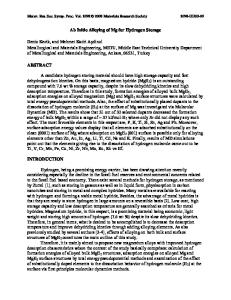Ab initio based large-scale screening of hypothetical MOFs for carbon capture application
- PDF / 7,989,732 Bytes
- 6 Pages / 612 x 792 pts (letter) Page_size
- 53 Downloads / 296 Views
Ab initio based large-scale screening of hypothetical MOFs for carbon capture application Thomas D. Daff1 and Tom K. Woo1 1 Centre for Catalysis Research and Innovation, Department of Chemistry, University of Ottawa, Ottawa, ON K1N 6N5, Canada ABSTRACT Metal organic frameworks (MOFs) are porous solids that are potential high performance carbon capture materials. We have mined a hypothetical MOF database for structures that have exceptional low-pressure CO2 adsorption properties. We have applied the REPEAT method to generate accurate atomic charges that regenerate the ab initio electrostatic potential. We show that large scale screening at high accuracy is feasible for thousands of structures. We identify promising synthesis targets, like a simple combination of chrysene linker and vanadium inorganic unit, and examine in detail structural features that make better performing MOFs from those that would not be synthesisable. We find that, although screening large numbers of hypothetical structures is necessary to provide experimental targets, there are limitations to the suggestion of using the this database directly for synthesis targets and propose improvements and constraints that should be incorporated into the design of further generations of such a buildingblock algorithm to reach the accuracy required for high-quality CO2 adsorption simulation. INTRODUCTION Carbon capture currently represents the most serious developed strategy for mitigation of global climate change due to greenhouse gas emissions from fossil fuel based power generation.1 The field of nanoporous materials for carbon capture and storage is arguably at the forefront of current materials design.2 Metal organic frameworks (MOFs) are porous crystalline solids that physisorb CO2 and are regenerated with lower energy penalties than current technologies. The limitless combinations of metal ion based units and organic linker molecules push the capabilities of current predictive methodologies to provide better sorption materials. Until recently, prediction of porous structures was done manually for limited number of structures, however, Wilmer et. al reported a new computational strategy to rapidly generate thousands of new, hypothetical, MOF structures.3 The generation is approached as a combinatorial problem, with each inorganic unit combined like a Tinker-Toy with every combination of up to two different organic groups and decorated with functional groups to ‘functionalise’ the included pore space. The search space for this becomes very large, and, as part of their work they released a database of over 137,000 unique structures created from a library of 5 metal centres, 42 organic linkers and 13 functional groups. In that work a new material for methane storage with the potential to beat the currently best performing material was identified and synthesised, demonstrating the predictive capacity of this method. Determination of methane storage capacity by simulation is relatively simple as a unified atom methane model with no electrostatics produces hi
Data Loading...










